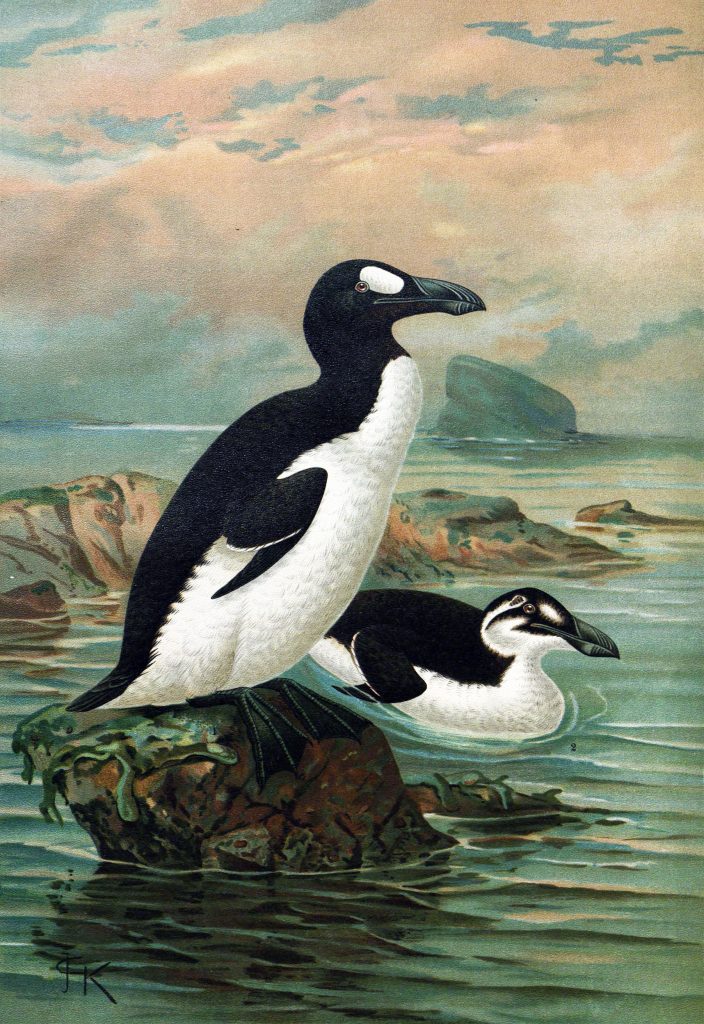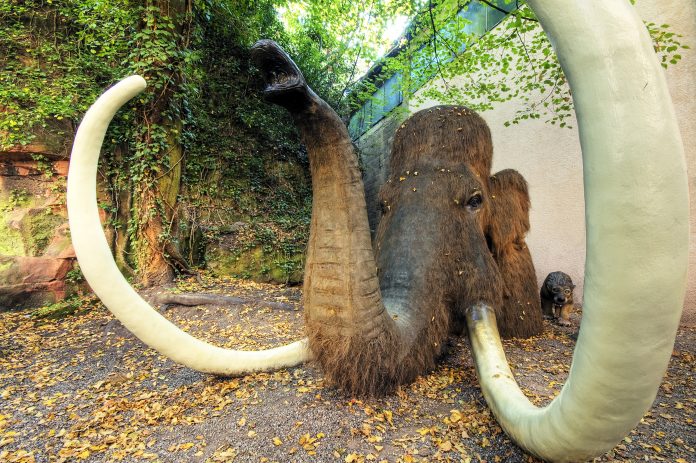(THIS ARTICLE IS MACHINE TRANSLATED by Google from Norwegian)
"It was not the intention that the mammoth should disappear. It was lost because we ate it up, "says Petter Bøckman, senior lecturer at the Natural History Museum, to Ny Tid. We meet Bøckman in idyllic surroundings in a botanical garden. He quickly apologizes for the Viking costume he is wearing – he has just arranged activities for a group of children. Bøckman has no ethical objections to reintroducing extinct species. It will simply be to make up for our past mistakes, he believes. "We are the ones who have exterminated these animals in the first place. Is there any question ethically in this context? " he asks. In particular, he wants the vulture back. The vulture was common until the Viking Age, and the last one was shot in 1844. «The vulture is a Norwegian animal, and we should have had it here. It is a sad fact that we have not been able to keep the vulture at bay, "says Bøckman.
 The Geirbird sounds relatively harmless, but it is not free for it to become a political battle theme if we manage to bring the mammoth, the cave lion or the woolly rhino back into Norwegian nature. Both the mammoth and the woolly rhinoceros were herbivores, but with a body mass of around six and three tonnes respectively, it is still not free for reindeer husbandry to become a significantly more risky occupational route if they were to graze side by side with the reindeer in Finnmarksvidda sometime in the future. . The cave lion could be up to 120 centimeters above the shoulders and have a body length of over two meters. This cold-adapted lion was thus a good deal larger than the lions we find in Africa today. "It is possible that Norwegian sheep farmers will be a little fierce if we introduce cave lions," says Bøckman, laughing heartily. "The cave lion is a little difficult animal, because it is an animal that sometimes eats people. Bøckman believes it will still be possible to teach cave lions that they should stay away from humans using the same methods used today on polar bears in Canada.
The Geirbird sounds relatively harmless, but it is not free for it to become a political battle theme if we manage to bring the mammoth, the cave lion or the woolly rhino back into Norwegian nature. Both the mammoth and the woolly rhinoceros were herbivores, but with a body mass of around six and three tonnes respectively, it is still not free for reindeer husbandry to become a significantly more risky occupational route if they were to graze side by side with the reindeer in Finnmarksvidda sometime in the future. . The cave lion could be up to 120 centimeters above the shoulders and have a body length of over two meters. This cold-adapted lion was thus a good deal larger than the lions we find in Africa today. "It is possible that Norwegian sheep farmers will be a little fierce if we introduce cave lions," says Bøckman, laughing heartily. "The cave lion is a little difficult animal, because it is an animal that sometimes eats people. Bøckman believes it will still be possible to teach cave lions that they should stay away from humans using the same methods used today on polar bears in Canada.
Extermination of the mammoth. Newer genetic technology means that the dream of mammoths in Finnmarksvidda can become real in the near future. A research group at Harvard University is already bringing the mammoth back to life. The plan is to use the Indian elephant, which is actually more closely related to the mammoth than to today's African elephant, to carry out cloned mammoth fetuses. The method is nuclear cloning, where one takes an egg cell from a host animal and replaces the cell nucleus so that the egg cell gets the genetic material of the animal you want to clone. The DNA is obtained from mammoths that are relatively well preserved in Siberia's permafrost.
"The cave lion is a little difficult animal, because it is an animal that sometimes eats people. Then the Norwegian predator debate may be a bit stifled. ”
Bøckman has a simple explanation as to why one has chosen to try to bring the mammoth back: "Because the mammoth is big and nice!". A large reserve has already been established in Russia, called the Pleistocene park after the era that covers the last ice ages. Here they have introduced both musk and European bison, and are ready to receive mammoth. The idea is to get to safari tourism. "Today people pay millions upon millions of dollars to see zebra, lion and wildebeest," Bøckman points out. "There is no reason why people should not pay as much to see European bison, musk and mammoth."
The mammoth can also prove to be an important utility animal. George Church, the geneticist who leads the mammoth project at Harvard, points out that the mammoth can play an important role in restoring the original Siberian ecosystem. He is based on research by Russian geophysicist Sergei Zimov. If the permafrost in the tundra melts, huge amounts of greenhouse gas methane will be released, which will accelerate global warming. According to Zimov's research, large herbivores on grazing will help maintain the grassland, which in turn will stop soil erosion and thus protect the permafrost that lies beneath. In winter, the animals will dig up the insulating snow in search of food, thus causing the cold to pull down into the soil.
Expensive and difficult. Although genetic research has made enormous strides in recent decades, cloning extinct animals is still a very complicated affair. "To get extinct animals back, you need two things," explains Bøckman. "You need good DNA material, and you need a close enough relative who can act as an egg donor and incubator. There are challenges for some species. For example, the giant armadillo, the giant dove animal and the mastodons, which became extinct in relatively recent times. They have no close relatives, so there is nothing we can do to get them back. " Whether the Indian elephant is closely related to being able to carry a mammoth remains to be seen. "The Indian elephant is, for example, a warm-weather animal, while the mammoth is a cold-weather animal, so there may be cuts, but we do not know until we have tried," says Bøckman.
There is a lot of trial and error behind a cloned animal. The process is laborious and resource-intensive, but for the moment, only small research communities with little money are engaged in extinction. Bøckman talks about the process when Spanish scientists temporarily brought back the Pyrenees mountain goat in 2003. “They had made hundreds of eggs, of which only about 50 could be used. There were only seven pregnancies there, and finally only one goat, who died a few minutes after birth. " With the mammoth, it is also more difficult to find good genetic material that has not been degraded too much over time, and the Indian elephant also has two years of pregnancy. "Then it is clear that you are in a completely different cost framework," Bøckman points out. The goal of building up a whole population of sustainable genetic variation will therefore require a great deal.


